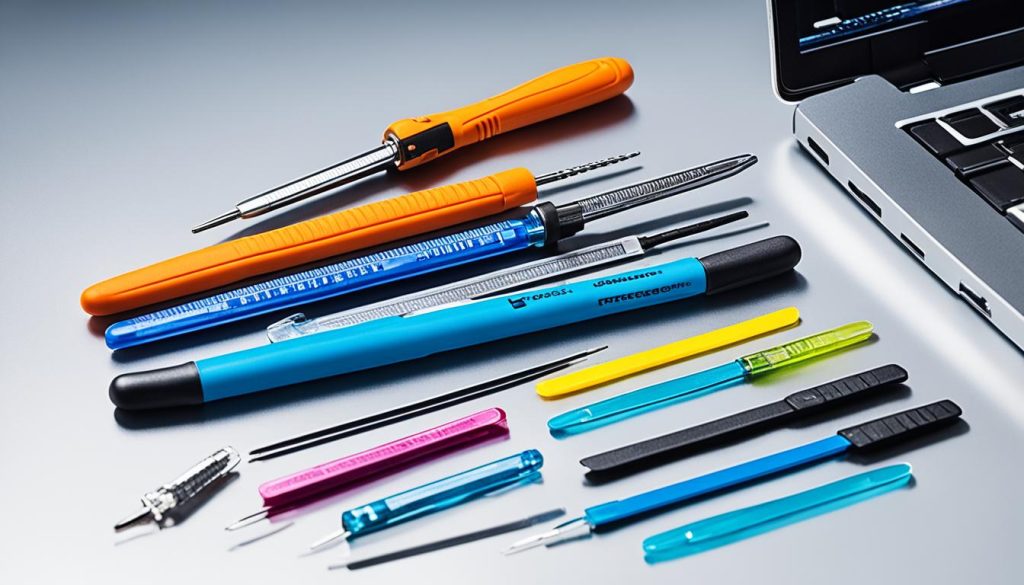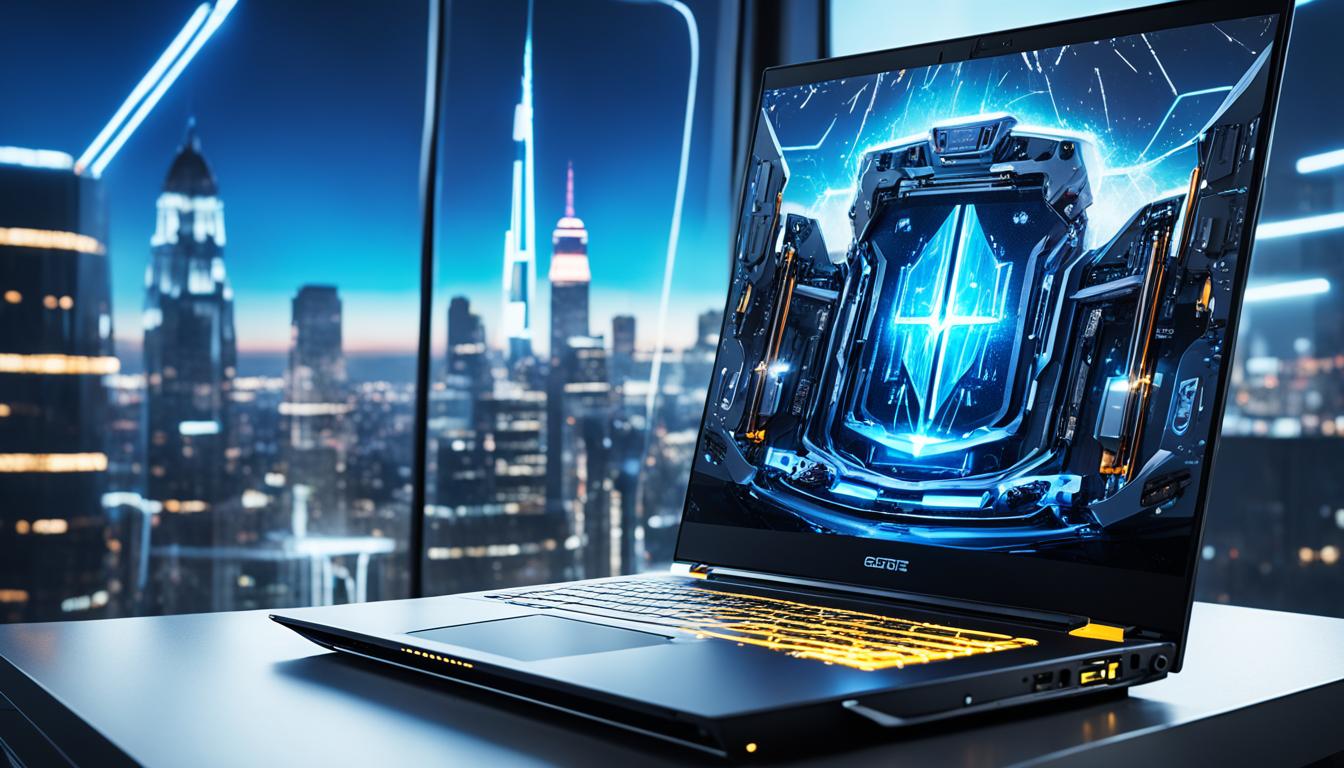Revolutionize upgrading your Elite laptops and notebooks for peak performance
Are you looking to take your laptop’s performance to the next level? Upgrade your Elite laptop or notebook to unlock unmatched performance enhancements and cutting-edge improvements that will elevate your tech experience and deliver optimal laptop performance.
While laptops may not offer the same level of flexibility as desktop PCs when it comes to hardware upgrades, there are still components that can be upgraded to enhance your overall experience. From increasing RAM to upgrading storage drives, battery packs, and wireless/Bluetooth cards, there are various ways to revolutionize your laptop’s capabilities.
Key Takeaways:
- Upgrade your Elite laptop or notebook for unparalleled performance enhancements.
- Enhance your tech experience with cutting-edge improvements.
- Optimize your laptop’s performance to achieve optimal results.
- Consider upgrading components like RAM, storage drives, battery packs, and wireless/Bluetooth cards.
- Ensure to consult the laptop manufacturer’s support site or service manual for specific upgrade guidelines.
Can Upgrades Void Your Laptop Warranty?
Engaging in laptop upgrades or replacing parts will not void the warranty of the laptop in and of itself, according to the Federal Trade Commission (FTC). However, it’s essential to consider that any damage that may occur from performing upgrades may not be covered by the warranty.
It’s recommended to seek professional help or consult the laptop manufacturer’s support site for guidelines regarding upgrades to avoid any potential warranty issues.
When it comes to upgrading your laptop, it’s important to strike a balance between improving performance and preserving warranty coverage. While upgrading components such as RAM, storage drives, battery packs, and wireless/Bluetooth cards can significantly enhance your laptop’s capabilities, it’s crucial to approach the upgrade process with caution.
“Don’t hesitate to reach out to professionals for assistance, and always refer to the manufacturer’s guidelines to protect your warranty.”
The laptop manufacturer’s support site or service manual for your specific laptop model should outline which components can be upgraded and provide instructions on how to do so properly. Following these guidelines will minimize the risk of damaging your laptop and voiding the warranty in the process.
It’s worth noting that some laptop models have limited upgradability. Processors (CPUs) and graphics chips (GPUs) are typically among the components that cannot be upgraded. Therefore, it is essential to research and understand the upgrade limitations of your laptop before making any purchasing decisions.
In summary, while performing upgrades to your laptop will not automatically void the warranty, it’s critical to exercise caution and follow the manufacturer’s guidelines to protect your investment.
What Can You Upgrade in Your Laptop?
When it comes to upgrading your laptop, there are several components that you can consider improving to enhance its overall performance. Depending on your laptop model, you may have the opportunity to upgrade the following:
- Main System Memory (RAM): Upgrading your laptop’s RAM can significantly increase its multitasking capabilities and speed. With more RAM, your laptop can handle larger files and run multiple applications without slowing down.
- Primary Storage: Consider upgrading your laptop’s primary storage drive to a solid-state drive (SSD) or a larger-capacity hard drive. An SSD provides faster data access and boot times, improving overall system responsiveness and reducing file transfer times.
- Secondary Storage: In larger laptop models, there may be an option to add secondary storage, such as an additional hard drive or SSD. This can offer more space for storing files, software, and media.
- Battery Packs: If your laptop’s battery life has significantly decreased over time, upgrading to a new battery pack can provide longer usage hours, allowing you to work or play without constantly searching for a power outlet.
- Wireless/Bluetooth Card: For improved wireless connectivity and compatibility, consider upgrading your laptop’s wireless card or Bluetooth module. This can provide faster internet speeds, stronger signal reception, and enhanced wireless device connectivity.
However, it’s important to note that not all laptop models allow for these upgrades, and the extent of upgradability varies between manufacturers and specific laptop models. To determine which components can be upgraded in your laptop, it’s essential to consult your laptop manufacturer’s support site or service manual for detailed information on your specific model.
Enhancing Laptop Performance Through Component Upgrades
By upgrading the aforementioned components in your laptop, you can experience noticeable improvements in performance and efficiency. Whether you need more storage space, faster data access, increased multitasking capabilities, or extended battery life, upgrading your laptop’s components can help you achieve your desired goals.
It’s important to research compatible upgrade options and ensure that any components you purchase are compatible with your laptop model. Consulting professional help or seeking guidance from the manufacturer’s support team can help you navigate the upgrade process smoothly and avoid any compatibility issues or damage to your laptop. Remember to also take warranty considerations into account, as performing upgrades may impact or void certain warranty agreements.
With the right upgrades, you can transform your laptop into a powerhouse that meets your specific needs and delivers a superior computing experience.
| Upgradable Laptop Components | Benefits of Upgrading |
|---|---|
| Main System Memory (RAM) | Increase multitasking capabilities |
| Primary Storage | Faster data access and boot times |
| Secondary Storage | Expanded storage capacity |
| Battery Packs | Extended laptop usage hours |
| Wireless/Bluetooth Card | Improved wireless connectivity and compatibility |
How to Upgrade Your Laptop
Before embarking on any laptop upgrades, it’s crucial to gather the necessary information and tools. By following a systematic approach and using the right laptop upgrade tools, you can ensure a smooth and successful upgrade process.
1. Consult the Manufacturer’s Support Site
Start by visiting the laptop manufacturer’s support site. Look for detailed instructions specific to your laptop model, as different laptops may have unique upgrade processes and limitations. The manufacturer’s support site will provide you with valuable insights on compatible upgrades and step-by-step guidelines.
2. Get the Right Tools
To carry out laptop upgrades effectively, you’ll need a set of essential tools. Make sure to have a Philips screwdriver as well as a star-head or Torx screwdriver for removing and securing screws. Additionally, consider using a magnetic parts tray to keep track of small screws and components during the process.
3. Prepare Your Laptop
Prior to starting the upgrade process, shut down your laptop and disconnect it from any power sources. This precautionary step ensures your safety and prevents any potential damage to the laptop or its components.
4. Open the Bottom Panel
To access the internal components, you’ll need to remove the laptop’s bottom panel. Carefully remove the screws that secure the panel, and set them aside in the magnetic parts tray for safekeeping. Keep in mind that the number and location of screws may vary depending on your laptop model.
5. Handle Components with Care
As you progress through the upgrade process, it’s important to handle each component with care. Avoid using excessive force or causing any damage to components or connectors. Refer to the manufacturer’s guidelines or service manual for specific instructions on removing and replacing components.
6. Access and Replace Desired Components
Once you have removed the bottom panel, you can access the internal components of your laptop. Identify the component you wish to upgrade, such as the RAM or storage drive, and carefully remove it according to the manufacturer’s instructions. Install the new component in its place, ensuring a secure and proper connection.
Remember to refer to the manufacturer’s guidance throughout the entire upgrade process, as it will provide you with invaluable tips and recommendations specific to your laptop model.

Upgrading your laptop can be a rewarding experience when done correctly. By consulting the manufacturer’s support site, using the right tools, and following a systematic approach, you can elevate your laptop’s performance and enjoy the benefits of the upgraded components.
Optimizing Your Laptop’s Performance
In addition to hardware upgrades, there are several software maintenance tasks that can help boost your laptop’s performance. By following these optimization techniques, you can ensure that your laptop is running at its best and enjoy a smoother user experience.
- Limited Startup Tasks and Programs: When your laptop starts up, numerous programs may also launch, slowing down the boot time. You can optimize performance by limiting the number of startup tasks and programs. To do this, access your task manager, navigate to the startup tab, and disable unnecessary programs.
- Uninstall Unused Software: Over time, you may accumulate unused or outdated software on your laptop, which can consume valuable system resources. By regularly uninstalling such programs, you can free up disk space and enhance overall performance.
- Use Disk Cleanup Tools: Disk cleanup tools help identify and remove unnecessary files, such as temporary files, system logs, and cached files, which can accumulate and slow down your laptop. Running these tools periodically will improve system responsiveness and free up storage space.
- Clear Your Internet Cache: Browsers store temporary files and website data in a cache to speed up page loading. However, an overloaded cache can hinder performance. Clearing your internet cache regularly can help optimize browsing speed and overall laptop performance.
- Utilize External Hard Drives for Storage: If you find that your laptop’s onboard storage is becoming overcrowded, consider utilizing external hard drives for storing less frequently accessed files. This can help free up space on your laptop and improve its performance.
- Run Spyware or Anti-virus Programs: Malware, viruses, and spyware can negatively impact your laptop’s performance and compromise your data security. Running regular scans with reliable spyware or anti-virus software can help detect and remove these threats, ensuring optimal performance.
- Regular Software Updates: Keeping your laptop’s operating system and software up to date is essential for optimal performance and security. Software updates often include performance optimizations, bug fixes, and security patches. Regularly running software updates will ensure you have the latest improvements.
By implementing these software optimization techniques, you can significantly boost your laptop’s performance and enjoy a faster, more efficient computing experience. Remember to combine these strategies with hardware upgrades for the best overall results.

Conclusion
Upgrading your Elite laptop can unlock unparalleled performance enhancements and elevate your tech experience. By identifying the upgradable components, following the correct upgrade process, and optimizing your laptop’s performance through both hardware and software maintenance, you can ensure that your laptop is running at its optimal performance level. Remember to refer to the laptop manufacturer’s support site or seek professional help if needed to avoid any potential warranty issues and maximize the benefits of your laptop upgrades.
Investing in laptop upgrades can be a cost-effective way to breathe new life into your device, without having to purchase a brand new laptop. By upgrading your Elite laptop, you can enjoy increased speed, improved multitasking capabilities, and enhanced storage capacity. Whether you’re a gamer, a student, or a professional, these upgrades can make a noticeable difference in your daily activities, allowing you to accomplish more in less time.
Don’t let your laptop’s performance hold you back. With the right upgrades, you can unlock its full potential and enjoy a seamless computing experience. From increasing RAM to upgrading storage options, each component upgrade contributes to a more powerful and efficient laptop. So, if you’re ready to take your Elite laptop to the next level, consider upgrading and optimize your tech experience today.
FAQ
Can upgrading your laptop void the warranty?
Engaging in laptop upgrades or replacing parts will not void the warranty of the laptop in and of itself, according to the FTC. However, any damage that may occur from performing upgrades may not be covered by the warranty. It’s recommended to seek professional help or consult the laptop manufacturer’s support site for guidelines on performing upgrades to avoid any potential warranty issues.
What components can you upgrade in your laptop?
The components that can typically be upgraded in a laptop include the main system memory (RAM), primary storage (such as solid-state drives or hard drives), secondary storage (in larger models), battery packs, and the wireless/Bluetooth card. However, some components like the processor (CPU) and graphics chip (GPU) are almost never upgradable. It’s essential to refer to the laptop manufacturer’s support site or service manual for each specific laptop model to identify the upgradable components.
How do you upgrade your laptop?
Before performing any upgrades, it’s recommended to first consult the laptop manufacturer’s support site for detailed instructions or find a service manual specific to your laptop model. It’s also important to have the necessary tools, such as screwdrivers (both Philips and star-head or Torx) and magnetic parts trays, to safely open and work on the laptop. The general process involves shutting down the laptop, removing the bottom panel, carefully removing screws, separating the panel from the chassis, and then accessing and replacing the desired components. It’s crucial to handle each component with care and avoid forcing or damaging any parts.
How can you optimize your laptop’s performance?
In addition to hardware upgrades, there are several software maintenance tasks that can help optimize your laptop’s performance. These include limiting startup tasks and programs, uninstalling unused software, using disk cleanup tools to remove unnecessary files, clearing your internet cache, utilizing external hard drives for storage, running spyware or anti-virus programs, and regularly running software updates. These actions can help free up resources, improve system responsiveness, and ensure your laptop is performing at its best.
What are the benefits of upgrading your laptop?
Upgrading your Elite laptop can unlock unparalleled performance enhancements and elevate your tech experience. By identifying the upgradable components, following the correct upgrade process, and optimizing your laptop’s performance through both hardware and software maintenance, you can ensure that your laptop is running at its optimal performance level.
